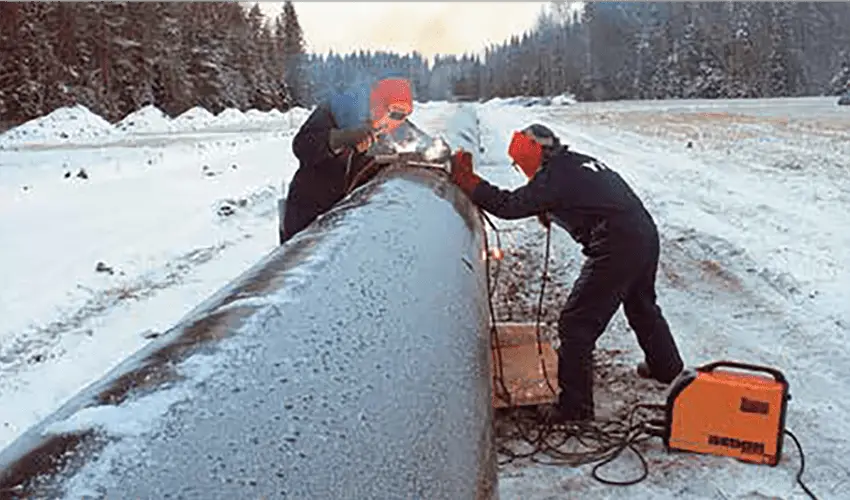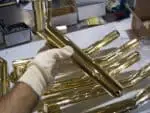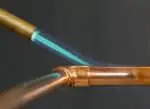Welding is the business of heat and thermal energy. The temperatures of the welding arc are soaring high so that heat is generated and metals are welded together to perfection.
Naturally, since heat is crucial for welding, as a welder you might be curious to know if you can weld when it’s cold! Although a matter of high temperature, it’s still possible to weld when it’s cold. However, there’s a certain limit to it.
Every metal is different. Perse, the ductility of steel becomes too low below 0° C. It’s not that you cannot weld steel below this temperature, it’s just that steel will become very brittle and susceptible to cracking below 0°C.
If you take the stainless steel in question, its ductility is -200°C. It means stainless steel won’t get brittle until the temperature drops below -200. So, does it mean you can weld at this temperature?
The answer is more about common sense: there’s absolutely no way that anyone will ever have to weld at such low temperatures. Even the Arctic isn’t that cold, really!
To answer the question more precisely and directly, let’s just say, welding in cold weather is possible. But the feasibility depends on how cold it is, is the metal or welding machine moist or frozen, whether you’re working indoor or outdoor, are you wearing the right PPE for welding, and also which two metals are you trying to weld!
Interestingly, there’s also a technique that’s known as cold welding, and people are often confused whether or not it’s a different term used for welding in the cold. We will also touch on the cords of this piece of info in this post.
Since too many chefs can ruin a dish, let’s not make things complex and answer everything about welding in the cold one by one. By the end of this guide, you’ll have all the answers explained: can you weld when it’s cold, and should you weld when it’s cold!
How Cold is too Cold to Weld?
Welding can be generalized into two types: indoor welding and outdoor welding. Indoor welding has a more controlled environment, but outdoor welding doesn’t have that leisure.
The weather conditions outside can be very harsh and very cold. Still, construction of commercial structures (for instance bridges and buildings) and repair of city pipelines (etc.) cannot be put on hold even when the temperature drops below freezing point (0°C).
Clearly, welding in the cold is possible, even below 0°C. However, it gets too risky to weld when the temperature drops below -10°C.
Still, some cities in the US like Fairbanks have an average minimum temperature of -16.9°C. In Alaska, the minimum temperature recorded has even gone up to -62.2°C once in the January of 1971.
Although the extreme weather in Alaska can put construction welding on hold, for less extreme cities like Fairbanks and Hampshire, welding in the cold and snow has happened and does happen.
Anything below -10°C is too cold to weld. If you have to weld below this temperature, there will be complications and risks. Having said that, it can still be carried out.
Should You Weld When It’s Cold?
Ideally, you shouldn’t! But practically, you can! It’s pretty much legal. The ASME (American Society of Mechanical Engineers) suggests not to weld before -10°C, but it doesn’t prohibit welding below this temperature.
In fact, even according to ASME, pipelines can be repaired and welded at -18°C. So, there’s no legal hard and fast rule about the temperature you can weld at.
As long as you can control things at the site of construction (ensuring you do not compromise public safety), you can pretty much weld below 10 degrees from the freezing point without worrying about legal fiascos. Also, you need to wear proper PPE to weld at such low temperatures.
Welding in the Cold: The Details and Limits!
Now that you know the answers to can and should, there are certain facts about cold welding that you should be aware of.
We have compiled a list of questions that are most relevant to welding in the cold and answered every bit of what makes the most sense. Let’s begin!
1.) Can you weld in the snow?
Although anything slightly above the freezing point is cold, temperatures below the freezing point when it snows are the real problems when welding. The metals to be welded can become moist and so can the equipment.
Does that mean you cannot weld in the snow? Well, absolutely not! You can weld in the snow with the proper equipment. As long as you can keep the metals and the welding machine dry, welding in the snow is possible.
2.) How does cold welder work?
The ideal temperature that a welding arc should achieve and maintain for seamless welding is 6500-10,000 F. But when cold welding, heat isn’t the only driving force.
Generating and maintaining pressure is just as important as heat. Besides, cold welding (also known as cold pressure welding) is slightly different from welding in the cold and snow!
Did you know that a few metals can be welded better at low temperatures? Think about astronauts in space! They cannot generate let alone rely on the heat generated at very high temperatures.
But, they still carry out repair and welding in space. The process is known as cold pressed welding. However, there is a need for special welding equipment and a controlled environment for cold welding! Period.
3.) What do you need to cold weld?
There are certain elements and conditions that have to be met when you’re planning to weld at low temperatures or when welding in vacuum (where there’s very little to no oxygen for igniting the welding arc).
Here’s what you need:
#1. Non-ferrous metals that are flat and clean are better candidates for cold welding.
#2. Since cold welding is more about pressure and less about heat, brittle metals cannot be welded using this particular welding method.
#3. Ensure what you’re welding with the cold welding method is either aluminum, copper, or gold.
#4. Suitable welding machines are mandatory. Cold pressure welding is unlike welding in the cold. The two machines used for cold pressure welding are, a) hand-operated cold welding machines and b), electric pneumatically operated machines.
4.) Does metal warp in cold weather?
If the cold is an outcome of snow, then yes! Metal in the snow can warp. You might be surprised to know that warping is also a threat when the weather isn’t below 0°C.
So, it’s as much about skills as it is about the cold when it comes to metal warping during welding.
5.) Can you weld aluminum in cold weather?
Certainly, it can be welded using the cold pressure welding method that’s usually used in outer space or when the diameter of the metals being welded isn’t too wide, but when it comes to welding aluminum in cold weather in the snow, it’s a different matter altogether.
If you have to weld aluminum when it’s snow cold, you should preheat the metal. Don’t preheat it at very high temperatures though.
This controlled method of preheating aluminum before welding it in the cold will ensure that the metal won’t break and the joint won’t be brittle post welding.
6.) Does cold weather affect MIG welding?
Whilst air and rain are clear complications during MIG welding, temperature slightly below the freezing point shouldn’t be a matter of serious threat: considering you’re wearing the right PPE and the metal to be welded is dry!
The results are much better when welding indoors when it’s cold. But, outdoor welding in the snow using a MIG welding blowtorch is also possible. For best results, ensure the following conditions are met:
1.) Preheat the metal (whether it’s aluminum or cast iron).
2.) Wear welding glasses that don’t fog.
3.) Use insulated welding gloves that offer the best possible grip.
See also: Should You Use an Electric Welder Out in the Rain?
The Disadvantages of Welding in Cold – Can Cold Metal Break?
There are certain constraints of welding when the temperature drops below 0°C. We have discussed those flaws that are the most serious disadvantages of welding in the cold in the upcoming pointers. Have a look!
1.) The cold metal is brittle. Hence, it is pretty much susceptible to breaking.
2.) If the metal being welded in cold gets oxidized, it will break.
3.) The metal can warp when you’re welding in cold weather.
4.) The joint can easily break after welding if you weren’t careful. So, a weaker weld joint is another serious complication. It becomes a lot more threatening when the welding is concerned with repairing bridges and other structures for mass use.
Many people ask how do I know if my weld is too cold! The straight answer is that it will break very easily. You won’t have to even apply a lot of pressure, it will just break (at least, crack)! That’s how you know your weld is brittle.
Top 4 Precautions You Must Adopt When You’re Welding in the Cold
By now, you pretty much know that welding in the cold is not just possible but also legal. You also know the disadvantages and constraints of welding in the snow.
That’s why this bonus section on how you can make welding in the cold safer is going to be a delightful read. Skim through until the end!
1.) Preheat the metal you’re supposed to weld. The metal pool should be perfectly molten and the arc shouldn’t lag at all.
Using MIG welding is the best way to prevent oxidation post welding. Hence, these precautions are necessary if you want that the joint does not break or crack after welding.
2.) Wear the right PPE. Your clothes should be insulated and so should be your gloves and boots. You have to be warm, dry, and comfortable while you’re working outdoors in the snow.
It’s very important that you don’t lose grip of the welding machine. That’s why wearing the right welding gloves, boots, and clothes is so important.
3.) Welding glasses and the face shield you’re wearing should be anti-fog. Otherwise, your vision will be compromised.
4.) You, your welding machine, and the metal you’re supposed to weld should be dry. Make sure you’ve thawed the surface properly and dried it as well even before preheating the metal.
See also: Can You Weld On Wet Floor?
Concluding Thoughts:
Welding in the cold, under the snow, and below the freezing point is possible. You can weld without much issue up to -10°C with the right skills.
However, anything that’s even lower than -10°C requires special equipment and special preparation so that welding can take place smoothly.
We hope the right sets of information that we’ve provided in this guide have helped you take a call whether or not you would like to weld in the cold since it’s both possible and legal.
Bear in mind, don’t go overboard, don’t overestimate your skills and underestimate nature, and wear the right equipment and use the right machines.
As long as you follow all the guidelines, not only can you weld in the snow but even welding in a vacuum with little to no oxygen is possible!







